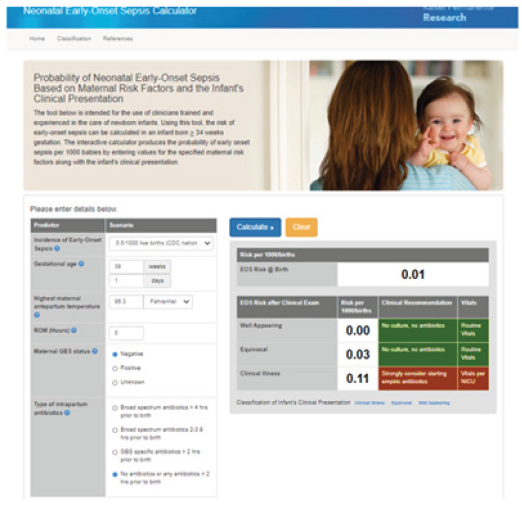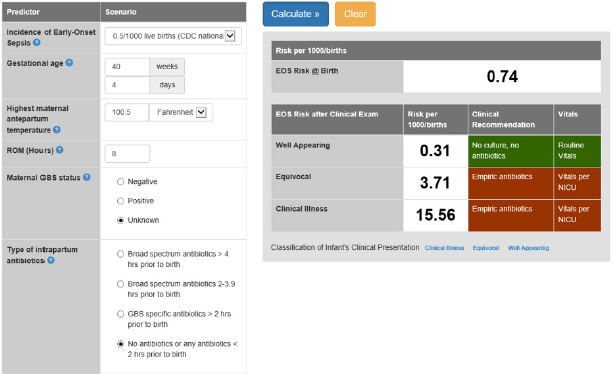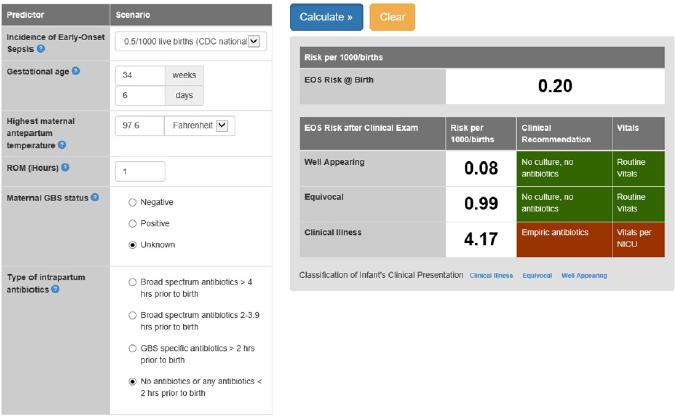Review Article 
 Creative Commons, CC-BY
Creative Commons, CC-BY
Antibiotics for Early Onset Sepsis in Newborn Infants
*Corresponding author: Shabih Manzar, 1501 Kings Highway, Shreveport, LA 71130, Telephone: 318-626-1623 Fax: 318-698-4305, USA.
Received: May 05, 2020; Published: June 22, 2020
DOI: 10.34297/AJBSR.2020.09.001379
Introduction
Excessive, uncontrolled use of antibiotic not only disrupt the neonatal microbiome but also lead to the development of antibiotic resistance [1]. Strict stewardship is therefore should be followed when caring for newborn with suspected early onset sepsis. In addition to the clinical assessment and laboratory analysis, we found the early onset sepsis (EOS) calculator, an online tool, extremely helpful [2]. Here we present the outline of three neonatal cases that highlights on the clinical utility of the EOS calculator.
Case 1: A newborn is born at 39 1/7weeks, maternal temperature was 96.3 °F, rupture of membrane at delivery, negative maternal group B streptococcus (GBS) screen, and no use of intrapartum antibiotics.
Early onset sepsis calculator has 2 components:
- Risk with recommendation
- Classification on clinical presentation
1) EOS calculation on the case, part A (putting the information in the appropriate section): Initial assessment/calculation at birth shows the risk to be 0.00, ‘no culture, no antibiotics’, see below Figure 1.

Figure 1: Infant showed signs of respiratory distress and was transferred to NICU, infant remained on O2 support > 2 hr.
2) EOS calculation on the case, part B (Physical Examination): Infant showed signs of respiratory distress and was transferred to NICU, infant remained on O2 support > 2 hr. Antibiotics were started (at~20 hours of life) after looking at the complete blood count (CBC) that showed band count of 16, with IT ratio 0.23.
In this case, antibiotics should have been started earlier by following the EOS calculation (Figure 2).

Figure 2: Antibiotics were started (at~20 hours of life) after looking at the complete blood count (CBC) that showed band count of 16, with IT ratio 0.23. In this case, antibiotics should have been started earlier by following the EOS calculation.
Case 2
Infant was born at 40 4/7 weeks, maternal temperature was 100.5 °F, rupture of membrane was 8 hours, negative maternal group B streptococcus (GBS) screen, intrapartum antibiotics were given < 2 hours. Initial assessment/calculation by EOS calculator at birth shows the risk to be 0.31, ‘no culture, no antibiotics. Complete blood count (CBC) obtained twice were normal, C-Reactive Protein was < 0.27. Infant was weaned off oxygen in < 2 hours. No antibiotics were started. Infant was transferred back to the nursery.
In this case, antibiotics were rightly avoided by following the EOS calculation (Figure 3).

Figure 3: Complete blood count (CBC) obtained twice were normal, C-Reactive Protein was < 0.27. Infant was weaned off oxygen in < 2 hours. No antibiotics were started. Infant was transferred back to the nursery. In this case, antibiotics were rightly avoided by following the EOS calculation.
Case 3:
34 6/7 weeks, maternal temperature was 97.6 °F, rupture of membrane was one-hour, negative maternal group B streptococcus (GBS) screen, no use of intrapartum antibiotics. Initial assessment/calculation at birth shows the risk to be 0.08, ‘no culture, no antibiotics.’ Infant was admitted to NICU for prematurity (34-week gestation), complete blood count was normal. Antibiotics were started by the on-call team (which was later discontinued).
In this case, antibiotics could have been avoided by following the EOS calculation (Figure 4).
Conclusion
If a newborn is showing signs of respiratory distress that require supplemental oxygen for greater than 2 hours, the staff should obtain a blood culture and start broad spectrum antibiotics.
For suspected infection (maternal fever >100.4 °F (38°C), suspected chorioamnionitis, group B streptococcus positive/unknown, prolong rupture of membrane), the staff should use the EOS calculator.
Information needed for EOS calculation:
- Gestational age (week/day)
- Maternal fever (°F or °C)
- Rupture of membrane (hours)
- GBS status (positive, negative, unknown) [3]
- Intrapartum use of antibiotics (> 4 hours, 2-3.9 hours, > 2hours, no or < 2 hours)
Look at both the components of EOS:
- Risk with recommendation
- Classification on clinical presentation
If no antibiotics were started at birth, reassess/exam at 2-4 hour and follow complete blood count (CBC) and C-reactive protein (CRP) results, if clinical status worsens (see EOS chart) or CBC/CRP results suggestive of infection, consider antibiotics.
A word about maternal fever alone versus chorioamnionitis: [4]
Chorioamnionitis is defined clinically as a combination of maternal fever >100.4, maternal leukocytosis >15,000, foul smelling amniotic fluid, uterine tenderness. Fever alone, especially noted after epidural or post-partum, should not be used as a sole criterion to start antibiotics in neonates.
References
- Pherson McC, Liviskie C, Zeller B, Nelson MP, Newland JG (2018) Antimicrobial Stewardship in Neonates: Challenges and Opportunities. Neonatal Netw 37(2): 116‐123.
- https://neonatalsepsiscalculator.kaiserpermanente.org/
- Jennifer RV, Lesley McGee, Stephanie JS (2010) Prevention of Perinatal Group B Streptococcal Disease: Revised Guidelines from CDC. MMWR 59: 1-32.
- https://www.ncbi.nlm.nih.gov/pmc/articles/PMC6831045/




 We use cookies to ensure you get the best experience on our website.
We use cookies to ensure you get the best experience on our website.